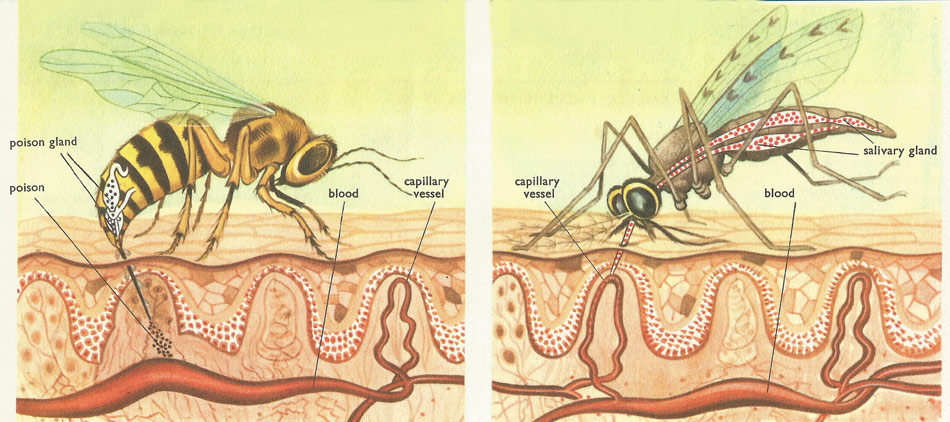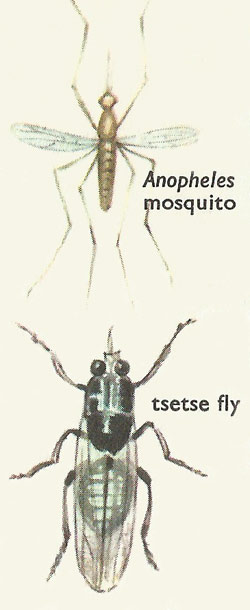insects that bite and sting

How insects sting and bite. Left: A wasp sting, which serves as a weapon. Right: A mosquito's sharp beak is used for sucking.

Mosquito and tsetse fly.
Among the many thousands of different kinds of insects a number can bite or sting humans. In some cases this is a serious matter, for biting insects may carry disease. The way they convey the infection is as follows: the insect first bites and sucks up the blood of a person suffering from some particular disease, and later, in biting a healthy person, it injects some of its saliva into the blood of this healthy person and so infects them with the disease microbes. Examples of this are: the Anopheles mosquito, a particular kind of mosquito found in swampy areas, chiefly in tropical countries, which conveys malaria; the tsetse fly of equatorial Africa, which transmits sleeping sickness; the louse, which conveys the virus of typhus; and the rat-flea, which carries the bacillus of bubonic plague. Fortunately, ordinary fleas do not infest rats and so do not carry the disease.
There is a difference between stinging and biting insects. The wasp and the bee carry a sting at the tip of the tail. This is connected with a gland containing poison and is a weapon, having nothing to do with the insect's feeding. In action it works exactly like the doctor's hypodermic syringe; the sting, like a little hollow needle, pierces your skin and some poison is injected.
Unlike that of a wasp, the sting of a bee is barbed and can only with difficulty be pulled out of the victim's skin. For this reason bees often leave their stings behind them in the wound they have made, but the injury resulting from tearing the sting out of the bee is so severe that it soon dies.
A mosquito does not sting but 'bites'; that is to say, it pierces your skin with its beak, which is like a tiny hollow needle. Its object is not to attack you, or defend itself, but to feed on your blood. Before it sucks up the blood it injects some of its saliva in order to keep the blood from clotting in the very fine tube through which it is being sucked. It is this saliva which causes the irritation of a mosquito bite and which conveys the germs if the insect is carrying disease.
Other insects which bite in this way are biting flies, such as horse-flies, midges, and the tsetse fly; bugs, like the bed-bug; and fleas. Only biting insects carry and transmit disease, never stinging insects.
Biting insects in Britain
In Britain we have little to fear now from biting and stinging insects. None of the native wasps and bees are really dangerous, as some of the large tropical species are, and insect-borne disease is practically non-existent. At one time, however, this was by no means the case. Until about 1860, malaria, which was known as 'ague', was a common illness, especially in the fen country of East Anglia. The mosquito which carried it, Anopheles maculipennis, is still there, but the disease has disappeared. Typhus was very frequent in recent historic times. In conditions of poverty and squalor people get infected with lice, which convey the disease from one person to another. Because it was rife in the crowded and filthy prisons of those times, typhus was called 'gaol fever'. Plague or 'Black Death' used to kill thousands of people; it is a disease of rats conveyed to humans by fleas which leave the rats when they die.


